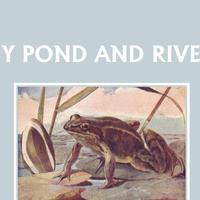CHAPTER 3. DOWN BELOW
TO-DAY we will use our net. Hold the stick tight, and throw the net out into the pond as a fisherman throws a fly. Then the stone will sink the net slowly. If now you pull it gently through the mud and water-plants, you are sure to get something.
Bring the net to land and lower it on the grass, and put all you can find into the clear water in the bottle. You may find a little fish, or some tadpoles, or water-snails. Or there may be one of the curious creatures shown at a , on page 10. I'm sure you would not think this was the grub of a dragon-fly. But it is. It is a long insect, all joints, with six legs, and eyes something like those of the dragon-fly. It has no wings, but a curious kind of arm, with pincers at the end, comes out from under its chin.
This is really part of its under-lip. It is called a mask, and has a hinge, so that it can be folded back under the chin. Now when the grub wants food, he waits quietly in the mud, till a beetle or a water-bug passes by. Then he throws out his mask, and catches his prey with the pincers.
Look next at the end of its tail. Sometimes it is pointed, sometimes it opens out like the leaves of a flower. When it is open the grub draws water in, and uses the air in it to breathe. Then it shoots the water out and so pushes itself across the pond.
This dragon-fly grub lives at the bottom of the pond for two years. So you ought to catch one sometime if you try. It changes its skin many times, and grows some wing-stumps. Then it creeps up a stem, as we saw in the last lesson, and becomes a dragon-fly.
And now what is this is our net? At first you may think it is only a bit of stick, or a piece of mud with little stones in it, or a number of bits of grass matted together. And so it is. But there is something alive inside. If you look carefully you can see the head of an insect sticking out with six legs behind it. This is a soft little creature called a caddis-worm. If you clear off the pieces of grass, or stick, or small stones, or shells, you will find the soft grub inside. It has six legs and a number of little tufts under its body. It breathes with these tufts just as the tadpole does with its tufts.
You may often see caddis-worms creeping along the bottom of brooks, looking like tiny moving bundles of sticks or stones. You may pick them up without using a net. They build these cases round themselves to try to protect their soft bodies, which the fish like to eat.
By-and-by they will turn into little yellow-brown flies like moths. They rise and fall in the air over the water in the evening. We did not see them with the May-flies and gnats, because they do not like the sunshine.
You will very likely fish out a good many little water grubs in your net. But you must look carefully, for they are very small. Some have tufts all along their sides. These are the grubs of the gnats and May-flies you saw flying over the pond. They all live some time in the water. And when they come out into the air they do not live more than a few hours.

